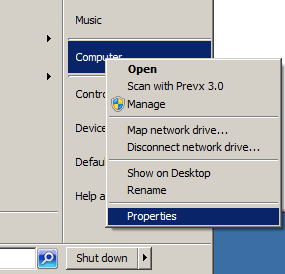Whether the copy Windows 7 you have on your computer is 32-bit or 64-bit can come up as a question when running into glitches during program installs. One quick troubleshoot can be to check if the program can even run in your install of Windows 7. This means checking whether 32-bit or 64-bit Windows 7 is installed.
Many programs are written to take advantage of the capabilities of a 64-bit operating system, such as being able to do things faster and make better use of your computer’s RAM (memory). This is especially noticeable in memory-intensive programs like Adobe Photoshop.
Do the following steps to check whether your computer’s Windows 7 install is 32-bit or 64-bit.
1. Click the Start button.
2. Right click the word Computer. It will probably be on the right.

3. Scroll down and click Properties. This will bring up a large window called System with several categories of information.
4. Near the middle of the System window you just opened is a section (somewhat redundantly also called System), which details the basic specifications of your Windows 7 operating system. Look for the phrase System type, which will tell you whether you’re running a 32-bit operating system or 64-bit operating system.

The System window is also a worthwhile place to familiariaze yourself with in general, because it contains a good deal of basic information about your computer, such as which edition of Windows you’re running, how much RAM is installed, what kind of CPU is installed, and more. Now that you know which version of Windows 7 is installed, you have access to all of that other data as well.
Many programs are written to take advantage of the capabilities of a 64-bit operating system, such as being able to do things faster and make better use of your computer’s RAM (memory). This is especially noticeable in memory-intensive programs like Adobe Photoshop.
Do the following steps to check whether your computer’s Windows 7 install is 32-bit or 64-bit.
1. Click the Start button.
2. Right click the word Computer. It will probably be on the right.
3. Scroll down and click Properties. This will bring up a large window called System with several categories of information.
4. Near the middle of the System window you just opened is a section (somewhat redundantly also called System), which details the basic specifications of your Windows 7 operating system. Look for the phrase System type, which will tell you whether you’re running a 32-bit operating system or 64-bit operating system.
The System window is also a worthwhile place to familiariaze yourself with in general, because it contains a good deal of basic information about your computer, such as which edition of Windows you’re running, how much RAM is installed, what kind of CPU is installed, and more. Now that you know which version of Windows 7 is installed, you have access to all of that other data as well.


No comments:
Post a Comment